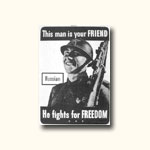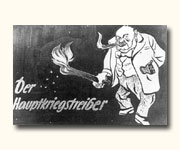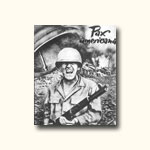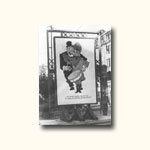
P
r
e
f
a
c
e
1
Dieter Vorsteher
The Image of America as the Enemy
in the Former GDR
1. Pax americana - Pax sovietica

At the end of World War One the world polarized into two dominant social
systems: capitalism and democracy on the one hand, bolshevism and socialism
on the other. By the time of the October Revolution in 1917 the foundation
of the Soviet state had given socialism a geographical home, just as North
America was recognized as the motherland of capitalism.
Both systems had emerged from revolutions and both promised prosperity,
happiness and peace for all members of society. This new constellation
encouraged rivalry between the systems which was anything but peaceful,
particularly when the aggressive dictatorships of Italy, Germany and Japan,
mixing socialist, capitalist and nationalist elements, appeared on the
scene. Throughout the world the twentieth century was in a permanent state
of war. It was a conflict played out not only in bloody wars but also
in images: political iconographies were created to illustrate the respective
political messages. Under the slogan "art as weapon", propaganda
pictures from World War One and the Twenties provided a source for the
production of old and new images of the enemy. "Devil" and "snake",
"rat" and "parasite", "monster" and "dead
man" updated visions of horror borrowed from the images of the Middle
Ages and mobilized man's most primitive fears. Used in combination with
symbols of topical political issues, class warfare and nationalism, this
picture Propaganda defamed the enemies on both sides. The capitalist hyena
and Wallstreet shark encouraged anti-capitalist images just as the Bolshevik
monster generated anxiety and fear of an "Asiatic" brand of
communism.
Agitprop, a tool tried out by both political camps during the Weimar Republic,
was also taken up by the national socialists, who called for the destruction
of the "subhuman Bolshevik" and the fight against "international
Jewish financiers". This was none other than a synthesis of anti-communism
and anti-capitalism underpinned by racism. By adopting the practices of
the Bolshevik class struggle for its policy of racial extermination, while
at the same time sabotaging liberal world trade by wars of conquest, the
Nazis found themselves in glaring conflict with both social Systems and
succeeded in uniting them temporarily in opposition. For the Spate of
some five years (1941-1946) it appeared as though it might be possible
to bridge the gulf between the "Weltanschauung" or world view
of the "east" and "west" within the anti-Hitler coalition.
"This man is your friend. He figths for freedom" said an American
postet from 1942 depicting the friendly smile of a soldier from the Red
Army. lt needed to be said because it certainly was not obvious (see above).
Just as Nazi Germany defused the east-west conflict in the anti-Hitler
coalition, occupied Germany after 1945 became the touchstone for the viability
of this new alliance. The "Pax americana", the vision of a liberal,
democratic world seemed within reach, with even Moscow talking however
sincerely in terms of a democratic reform of Europe rather than a Bolshevik
world revolution. In terms of choice of words, both sides at the Potsdam
Conference still seemed to be in agreement on the Joint administration
of Berlin, the punishment and dispossession of Nazi war criminals, the
democratic re-education of the Germans, the establishment of a pluralistic
Party System and the Nuremberg trials.
Within the space of two years, however, disagreements with respect to
interpretation and political differentes had created sufficient issues
of conflict between the victorious powers to revive the stereotyped forms
of expression of the pre-war period. Enemy Images had apparently survived
the war years intact. The dispossession of "Nazi criminals"
in 1945 in the Soviet occupied zone went far beyond what the western allfies
had envisaged. The forcible merger of the German Communist Party and SPD
(Social Democrats) to form the SED (Socialist Unity Party) in April 1946
contravened the principles of democratic reform. By the summer of 1947
the rejection by the western powers of the reparations which the Soviets
had expected created deep mistrust an the Soviet side. By September of
the same year the "two camp theory" had been formulated, in
which the "peace camp" of the Soviet Union and the "camp
of the warmongers" in Western Europe and America stood implacably
opposed. The use of the Marshall Plan to build up the economy of Western
Europe was viewed in Moscow as the re-emergence of an aggressive "capitalism"
and "imperialism". The repressive measures of the Red Army in
Poland, on the other hand, and the Communist coup in Czechoslovakia in
1948 gave credence in western eyes to the threat of a "Bolshevik
world revolution." Old fears of the "Sovietization" of
central and Western Europe were rekindled.

The global conflict between the victorious powern led in 1949 to the foundation
of two German states. With the endorsement and approval of the respective
protecting powers the Federal Republic of Germany was established in autumn
1949 an the territory of the three western zones and the German Democratic
Republic (GDR) in the Soviet zone. This development in post war Germany
was to provide fuel for the word and picture propagandists although both
sides assumed the state of affairs would be temporary. It still seemed
as though fit would be possible to win back ground using Propaganda, remove
the division and establish an all German government.
According to Wilhelm Pieck speaking at the SED Party Conference in the
Soviet occupied zone in January 1949, fit was in the "national interest"
to drive "US imperialism", which had been "unmasked"
in the Soviet zone as the "legacy of Hitler fascism", out of
Europe.
The outbreak of the Korean war in June 1950 set the seal an the division
of Germany. The Soviet Union misjudged the consequences of the Soviet
sanctioned offensive by Communist North Korea against South Korea an US
policy in Western Europe. The war in southeast Asia gave the western allies
grounds to consider incorporating the Federal Republic into a European
Defense Community (EDC). When the concept of the Community was finally
defeated by the French parliament (August 1954) after years of parliamentary
negotiations between the Federal Republic and the western allies, the
door was opened for the Federal Republic to join NATO (May 1955). Against
this background the propaganda battles between the two German states reached
a new pitch. Since they are not included in either the catalogue or exhibition,
West German propaganda images are mentioned explicitly here (Note 1).
The darkest visions of popular anti-bolshevism were revived in an attempt
perhaps to justify in retrospect this part of Nazi propaganda. "Asiatic"
monsters once more threatened Europe. In 1951 fear of Communist infiltration
led the federal government to ban the Communist Party in West Germany,
although the ban was not confirmed by the Federal Constitutional Court
until 1956.

Fears of the spread of communism in West Germany were largely unfounded.
There was always a latent tradition of anti-communism as a result of Nazi
Propaganda, experiences of the war in the USSR and the refugees who fled
the GDR each day in their thousands. News of the political internment
camps in which over 150.000 people had disappeared by 1950 was already
filtering out although the scale is only now becoming known. Economic
success in the Federal Republic had in any case created broad acceptance
of the West German democratic model. By the mid Fifties enemy propaganda
with paint brush and drawing pencil had died down in the Federal Republic:
a catalogue from a West German department store was capable of generating
more unrest in the GDR than political tracts an West German democracy
could ever do. It was harder for the East German government because the
same latent
anti-communism existed in the Soviet zone/GDR. The policies of the occupying
power and the Communist Party/SED served to intensify and clarify these
feelings. The political, organizational and economic crises in the Soviet
zone/GDR were mostly self made. The class war pursued single mindedly
by the Communist Party/SED had driven out most of the country's economic,
political, artistic and intellectual elite. Thus the GDR managed to create
more enemies inside the country than outside, if one counts emigrant East
Germans living in "exile" in West Germany as home-made enemies.
For their images of the enemy, the East Germans also had to recourse to
old and trusted patterns of explanation. The crises which beset the GDR
(production stoppages, failed harvests, gaps in supply, strikes) were
presented as the result not of their suicidal class war politics but of
attacks by western agents and Saboteurs. There was always someone one
could accuse and then "find guilty" of not giving their Support
to the establishment of socialism.

The East German Office for Information created the climate for these prosecutions,
and it was from this office in the initial years, under the Supervision
of the SED's Central Committee, that the largest number of propaganda
items came. Propaganda became an essential means for the party to retain
power wjth posters, pamphlets, manifestos, banners and stage-managed demonstrations
directed at a home audience to mobilize the country against the enemy.
The constant confrontation with the real and supposed "enemies"
of the GDR contributed significantly to the militarization of East German
society.
The rhetorical aggression against imperialist enemies, as displayed an
the posters here, had the fatal consequence that the west, for whose consumption
the posters were not primarily intended, took the message to be an actual
threat. The world revolutionary events they forecast and militant gesturing
they depicted had little to do with the real dynamics of East German society.
It was whistling in the dark which became louder, the more successfully
the west organized itself and the tighter it united together within NATO.
Impressum :: Further information :: Guestbook :: Shop :: Home
